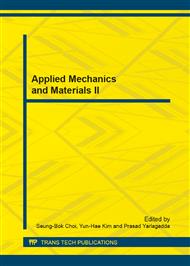[1]
Puertasa F., Palaciosc M., Manzano H, 2011. A model for the C-A-S-H gel formed in alkali-activated slag cements, Journal of the European Ceramic Society, 31, 2 043–2 056.
Google Scholar
[2]
Rashad A. M., Bai Y., Basheer P. A. M., 2013. Hydration and properties of sodium sulfate activated slag, Cement and Concrete Research, 37, 20-29.
DOI: 10.1016/j.cemconcomp.2012.12.010
Google Scholar
[3]
Hubler M. H., Thomas J., Jennings H., 2011. Influence of nucleation seeding on the hydration kinetics and compressive strength of alkali activated slag paste, Cement and Concrete Research, 41, 842–846.
DOI: 10.1016/j.cemconres.2011.04.002
Google Scholar
[4]
Fernandez J. A., Puertas F., Palomo J. G., 1999. Alkali-activated slag mor-tars: mechanical strength behaviour. Cement and Concrete Research, 29 , 593–604.
DOI: 10.1016/s0008-8846(99)00154-4
Google Scholar
[5]
Brough A. R., Atkinson A., 2002. Sodium silicate-based, alkali-activated slag mor-tars. Part I. Strength, hydration and microstructure. Cement and Concrete Research, 32, 865–79.
DOI: 10.1016/s0008-8846(02)00717-2
Google Scholar
[6]
Bakharev T., Sanjayan J. G., Cheng Y. B., 2002. Sulfate attack on alkali-activatedslag concrete. Cement and Concrete Research, 32, 211–216.
DOI: 10.1016/s0008-8846(01)00659-7
Google Scholar
[7]
- Bakharev T., Sanjayan J. G., Cheng Y. B., 2003. Resistance of alkali-activated slagconcrete to acid attack. Cement and Concrete Research, 33, 1 607–1 611.
DOI: 10.1016/s0008-8846(03)00125-x
Google Scholar
[8]
Puertas F., Mejia G. R., Fernandez Jiménez A., 2002. Alkaline cement mortars. Chemical resistance to sulfate andseawater attack. Materiales de Construccion, 52, 55–71.
DOI: 10.3989/mc.2002.v52.i267.326
Google Scholar
[9]
Collins F. G., Sanjayan J.G., 1999. Workability and mechanical propertiesof alkali activated slag concrete, Cement and Concrete Research, 29, 607-610.
DOI: 10.1016/s0008-8846(98)00236-1
Google Scholar
[10]
Yang K. H., Song J. K., 2009. Workability loss and compressive strength development of cementless mortar activated by combination of sodium silicate and sodium hydroxide. J Mater Civ Eng ASCE, 21, 119–27.
DOI: 10.1061/(asce)0899-1561(2009)21:3(119)
Google Scholar
[11]
Zhu S. J., Fang H. H., 2009. Influence of chemical admixture on binding performance of slag powder. Fly Ash, 21, 13-16. (In Chinese).
Google Scholar
[12]
Bakharev T., Sanjayan J. G., Cheng Y. B., 2000. Effect of admixtures on properties of alkali-activated slag concrete. Cem. Concr. Res, 30, 1 367-1 374.
DOI: 10.1016/s0008-8846(00)00349-5
Google Scholar


